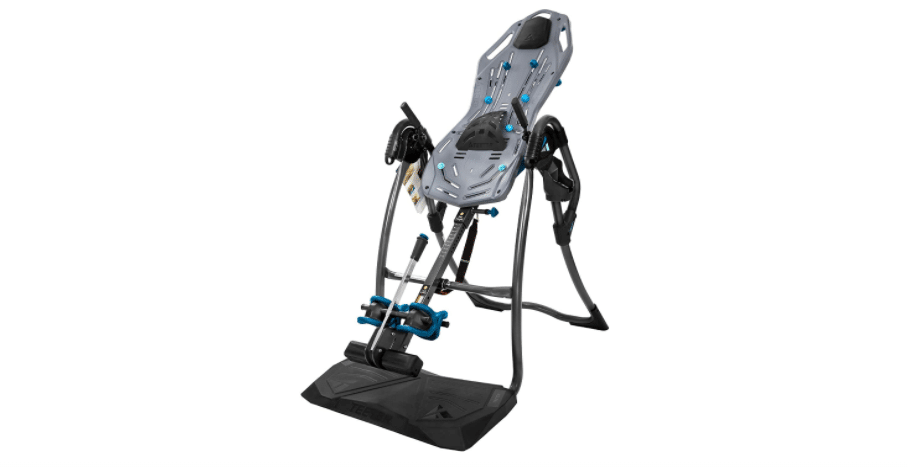
Inversion tables are devices that are used for performing spinal traction. In other words, they stretch and straighten out your spine.
So, what are the main benefits of using inversion tables and how exactly do they work? Inversion tables are designed to relieve back pain, sciatica, scoliosis, and other back issues caused by an overly-compressed or crooked spine. They work by hanging you upside down which requires you to use your own bodyweight to pull your spine into a longer, straighter shape.
But that begs a few other questions, like do inversion tables really work? And if so, how can you find a good inversion table?
In this article, we’ll look at the research on inversion tables, explain how to use inversion tables, and describe how to find the best inversion tables online.
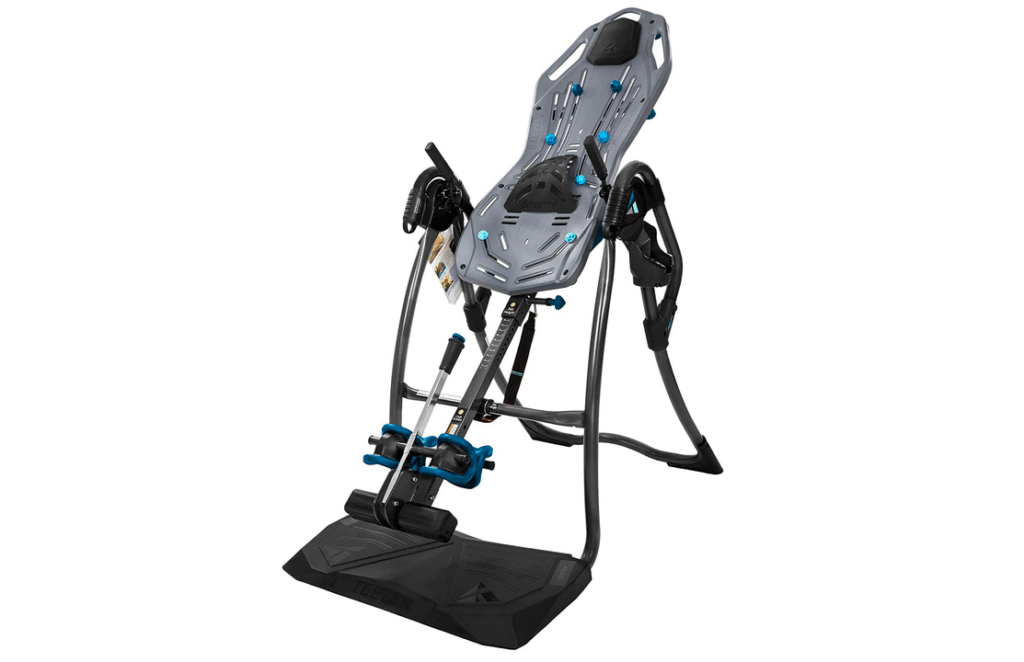
Looking to buy the best inversion table?
The Teeter Fitspine LX9 has everything you need in an inversion table, plus a bunch of extra features that just make life easier. These include a sleeker, more ergonomic frame for easier entrance and exit, a rubberized platform underneath the frame to help you step into the ankle holders, and a caddy next to one of the handles to hold things like your cell phone, beverage and a towel.
Inversion Table Studies
A handful of studies have been performed on the effectiveness of inversion therapy. While they generally find effectiveness in treating back issues and report only a few side effects, most authors state that more studies with larger sample sizes are required to further substantiate their efficacy.
We know that inversion therapy works, but until we have more research we can’t accurately quantify how well it works or the exact range of cases in which it works. And while side effects seem to be rare, it’s a little hard to say exactly how rare they truly are.
Inversion Tables And Disc Surgery Reduction
Regular inversion therapy can reduce back pain in cases of disc compression, nerve compression, sciatica, scoliosis, and possibly minor slipped disc injuries. It does this by reducing the root causes of back pain.
A 2012 pilot prospective randomized controlled trial conducted at Regional Neurosciences Centre in Newcastle Upon Tyne, UK compared the combination of inversion traction and physiotherapy with standard physiotherapy on its own in patients awaiting lumbar disc surgery. 24 patients were randomized for treatment with 13 receiving the inversion table and physiotherapy combination treatment and 11 receiving physiotherapy alone. Following several weeks of treatment, 10 out of 13 patients from the combination therapy group decided to forego surgery whereas only 2 out of 11 patients in the control group declined surgery. Thus, the results showed that intermittent traction with an inversion device significantly reduced the need for surgery.
Inversion Tables And Spinal Mobility
In addition to reducing back pain and potentially substituting for back surgery in minor cases, several studies have determined that inversion tables can improve back mobility.
A study from 1985 investigated a complete range of physiological parameters pertinent to inversion therapy and ran two different study samples. The first study evaluated changes in the following parameters within 40 subjects (29 males and 11 females) that received inversion therapy via Inverchair: forward and lateral trunk flexion, straight-leg raising, pulse rate, blood pressure, and paraspinal muscle activity. The second study investigated disc space separation in 16 subjects (all male) both before and after inversion therapy.
The study results demonstrated a significant increase in forward trunk flexion (25.5% greater), a general reduction of paraspinal EMG activity, and statistically significant increases in the intervertebral disc spaces with the following results: “the L4-5 interspace showed a mean increase of 1.65 mm anteriorly and .98 mm posteriorly; while the L5-S 1 interspace showed a mean increase of 2.24 mm anteriorly and 1.75 mm posteriorly.” Altogether, these findings established the use of Inverchair Therapy effective for appropriate clinical utilization.
Here’s an image of a female subject using Inverchair Therapy as part of the study:
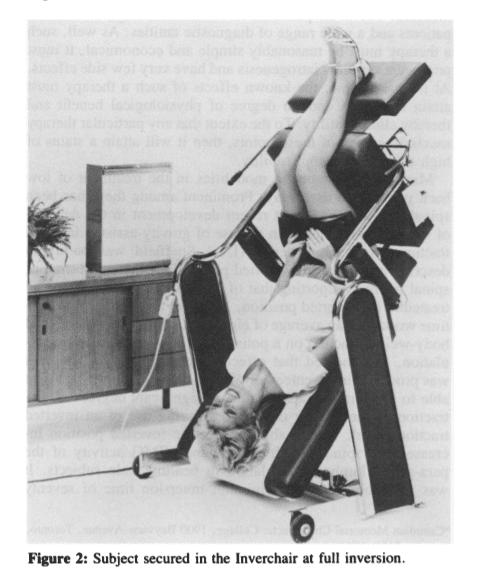
What Are The Side Effects Of An Inversion Table?
In general, most side effects resulting from inversion therapy are minor and not especially dangerous. Side effects reported in one study included increased blood pressure, decreased heart rate, periorbital and pharyngeal petechiae, persistent headaches, persistent blurred vision, and contact lens discomfort. Other studies, such as this one conducted on cardiovascular parameters in healthy adults following inversion therapy, report similar findings, with most of these side effects resolving within a short period of time following the conclusion of inversion therapy.
However, there are a few studies that have covered more serious side effects stemming from the misuse of inversion tables. One report reviewed 3 cases of cervical spinal cord injury that occurred in women in South Korea.
Let’s take a closer look at each of the side effects evaluated in these studies.
Increased Blood Pressure During Inversion Therapy
The study conducted in 1985 found “An average increase in blood pressure of 17.2 systolic (range 4-34) and 16.4 diastolic (range 2-50) while in the inverted position“. This did not continue after the inversion session was ended, and other studies have noted no long-term effects on blood pressure.
The study from 2019 also found slight increases in SBP (systolic blood pressure)/DBP (diastolic blood pressure) and PP which is the pressure difference between high and low blood pressure.
This is not nearly enough to be dangerous for most people, but it is something to be cautious about if you already have very high blood pressure and are at risk for a heart attack or a stroke. In fact, a stroke might be a bigger risk for reasons you’ll see in a moment.
Reduced Heart Rate During Inversion Therapy
The 1985 study found “An average decrease in heart rate of 16.4 beats per minute (range, 4-32)” and the 2019 study also determined there was a slight mean decrease in pulse rate.
This is interesting in combination with the raised blood pressure, as it suggests that the inverted position makes it easier for your heart to pump blood throughout your body, or at least to your brain.
Headaches
The study conducted in 1985 discovered that three out of sixteen subjects experienced persistent headaches. Now, persistent doesn’t mean permanent. However, it does mean that the headaches lasted well beyond the end of the inversion therapy session, however.
This is presumably due to blood pooling in the brain and increasing blood pressure, and could likely be reduced by using a shallower angle– which would of course weaken the benefits as well as the side effects, but you could then make your sessions longer. In any case, if you feel a headache coming on you should end your session, and keep water and ibuprofen on hand if you’re prone to headaches.
Blurred Vision
Three out of sixteen subjects in the 1985 study also noted blurred vision which lasted beyond the end of their inversion sessions. It’s not clear if these were the same three people who got headaches, though it seems highly likely.
This likely happens for the same reason as headaches– blood pressure in the head increases, including in the eyes, which presses on the retina or lens. The fix here would again be to use a shallower angle to reduce the impact on cranial blood pressure.
Note that this is why I said earlier that people at risk of stroke should be wary– blood pressure is not uniform throughout the entire body, and while blood pressure was measured in the arm, the increase was presumably much higher in the head. Indeed, most of the side effects seen appear to be attributable to increased blood pressure in the head.
Contact Lens Discomfort
One patient noted discomfort with their contact lenses during sessions. It’s unclear if this is due to pressure on the eyes, but it’s more likely that the inverted position simply caused their contact lenses to slip. In any case, this can be avoided by removing contact lenses or using a shallower angle.
Pharyngeal Petechiae
This side effect is quite an unusual one. Petechiae are little red spots on the skin caused by broken capillary vessels. They’re not a health issue at all, but they can be unsightly.
One of sixteen subjects from the 1st study noted pharyngeal petechia, meaning they appeared on the subject’s throat. This is likely because the inverted position stretched their throat out due to the neck being tilted back and/or stretched vertically.
This could maybe be avoided with a shallower angle or a small pillow under the neck, but it’s also minor enough that you might just put up with it and hope it stops after a while. In any case, it seems to be rare.
Cervical Spinal Cord Injury
A South Korean study reviewed 3 different cases of cervical spinal cord injury that occurred in individuals using inversion tables. Keep in mind that although the following injuries are quite significant, most people should not sustain injuries like these if they understand how to properly use an inversion table and secure themselves within the device, and are also monitored throughout their entire session. However, we wanted to provide you all with a glimpse at some of the more severe injuries and side effects that can occur from the improper use of inversion tables.
The 1st case involved a healthy 50-year old woman who slipped and hit her head while using a public inversion table. She immediately experienced a total loss of motor power and was transferred to the hospital for further care. She ended up undergoing anterior cervical discectomy and fusion (ACDF) of C5-6 and posterolateral mass screw fixation of C5-6. Following her operations, she was then transferred to the Department of Rehabilitation Medicine and received multidisciplinary rehabilitation therapy for 44 days. However, after displaying minimal improvement and experiencing a major decrease in quality of life (QOL), she was relocated to another hospital for long-term rehabilitative management.
The 2nd case involved a 63-year-old healthy woman who experienced the same injury as a result of falling while using an inversion table at a public health center. She also received surgery and underwent posterior open reduction and ACDF of C5-6-7. She was referred to the Department of Rehabilitation Medicine and received multidisciplinary rehabilitation therapy for 20 days. Following this, she was transferred to another center for long-term rehabilitation therapy.
The 3rd case once again involved another woman who was 58 years old and sustained similar injuries as a result of slipping from the inversion table she was using in her home. She underwent surgeries which included anterior corpectomy on C6 with ACDF of C5-6-7 and posterolateral mass screw fixation of C5-6-7. Similar to the above cases, her injuries were severe and required long-term rehabilitation.
Keep in mind that the above findings are individual cases, not studies conducted on larger populations. As such, you should refer to these studies as a reference for the potential extent of severity for side effects that may occur from improper use of inversion table machines but also examine current statistics on inversion table injury rates and read other studies conducted on larger population sizes to evaluate the extent and possibility of injuries that may take place.
How To Use Inversion Tables
Putting Together Your Inversion Table
All inversion tables share the same basic design. They tend to be shipped in large rectangular boxes, disassembled. The first thing you’ll need to do is unpack your inversion table and assemble it by following the instructions. This usually takes about 20 minutes and requires only a few nuts and screws and an Allen wrench, all of which will be included.
At the same time, you’ll need to figure out where you want to place your inversion table. Generally, you’ll want to place it against a wall, maybe in a corner, when not in use. However, due to their size and unwieldy shape, you’ll want this to be close to where you plan to use your table, so you only have to drag it a few feet each time you use it.
Setting Up An Inversion table
Once your inversion table is assembled, you’ll need to adjust the table to match your height. This is crucial for balancing the table properly; get it wrong and you either won’t invert or will invert too easily and you’ll have a hard time getting upright again. You adjust the height by changing the length of the main bar that runs vertically from the backrest to the ankle holder.
Second, you’ll need to select your desired angle of inversion. This is a simple matter of sticking a pin in one of the holes on the right armrest. The angles are mostly 15-degree increments– 15, 30, 45, 60, or 85 degrees, with 85 meaning you’re nearly upside down, and 15 meaning you’re almost lying flat.
When starting out, you should opt for shallower angles and slowly work your way up to steeper ones. 15 degrees doesn’t feel like much of anything, but 30 is a good starting point.
The last thing you’ll need to do before getting into your table is decide whether to use extra features like heat, a massage pad, or pressure point nodes. If you want to use those, get them into place now.
Next, step into the ankle brace and tighten it. It should be tight enough to hold your ankles securely without feeling like your circulation is being cut off. This tends to work best when wearing sneakers, as they provide some padding between the tops of your feet and the ankle holder, and some of the pressure will be applied to your shoes which will then spread it out across your feet.
If you’re using a massage pad, grab the remote control now– it’s harder to grab it after you’ve inverted.
Your First Inversion Therapy Session
Now you can start. You’ll need to invert yourself by extending your arms over your head. This is why it’s important to get the height adjustment right– if the table is perfectly balanced, simply raising your arms over your head will be enough to invert you, while bringing your arms back towards your legs will be enough to flip you upright. If it’s not quite perfect, you may have to sit up or pull yourself up slightly, but if this is difficult you need to adjust the height setting.
You’ll want to hang for about 5-20 minutes, depending on your tolerance, and the angle– steeper angles tend to be less sustainable and require more frequent breaks. Here’s the angle I typically use while on my inversion table:

During this time, pay attention to how you feel. Your back should feel like it’s stretching out and loosening up, but this should not be painful at all. Stop immediately if you feel any pain. Likewise, end your session early if you feel lightheaded or if you start to get a headache.
After your time is up, the final step is to get off the inversion table. Simply extend your arms down (or up, as the case may be) towards your ankles. If this doesn’t do it, you can help yourself up by doing a half-crunch or pulling on the handles– but if you need to do that, check the height setting and make sure it matches your actual height. Release the ankle brace, step out and you’re done.
What To Do After Inversion Therapy
After your session is over, take stock of how you feel– is your back loosened up? Are you dizzy or lightheaded?
If you experience any uncomfortable side effects, you may want to use a shallower angle or keep your session shorter. If you don’t feel much of an effect, you can try a steeper angle next time.
Finally, it’s good to follow up an inversion session with a bout of stretching or calisthenics, to take advantage of your loosened up back and work your spine through its full range of motion. This helps to build on the mobility improvements you’ve made and “lock them in” so they last longer.
What To Look For When Buying An Inversion Table
Inversion tables generally share the same basic design, but what differentiates them is the added features, as well as overall ease of use. Various inversion table models will have features such as massage pads, heated backs, stretch arms, or pressure point nodes. It’s also worth looking at how comfortable the product is.
Here are a few factors to consider when looking for an inversion table:
- Comfort – This is mainly going to center around the ankle holders, and how well they spread the weight around as well as holding the ankles securely. You can try to gauge this from photos, but customer reviews are ultimately your best source of information about comfort.
- Inversion Table Base – Does it slide easily, and is it smooth and padded so it won’t scratch your floors?
- Ease of Use– Are the ankle holders easy to reach? Are the arms of the table easy to grab if you need a little help tilting the table upright again?
- Massage Features– Does this inversion table have a massage function? If so, how many settings does it have? Can it target different areas of the back?
- Heat– Is there a heated back pad? This helps loosen up the muscles all along your back.
- Lumbar Support– Does it have a removable pad for maintaining curvature in the lumbar (lower back) region?
- Acupressure – Some inversion tables have acupressure nodes which can target very specific spots on your back. That’s worth considering if there are very specific areas you have pain in.
- Customer Service– Is there a good return policy? This is one good reason to buy on Amazon, as it requires sellers to adopt a very liberal return policy.
How To Find The Right Inversion Table On Amazon
It’s easy to find inversion tables on Amazon– there are around 20-30 models available from at least half a dozen brands. The trick is picking the right one.
First off, look at the feature list of each table and figure out which features you want, such as a massage or lumbar support, and make a shortlist of the tables that have your desired features. Make sure the tables on this list have multiple, clear photos of the product so you understand what they look like.
Second, research the brands on your shortlist. Do they have professional-looking websites that explain who they are and where they’re located? Have they been around a while? Are they reviewed on trustworthy websites other than Amazon?
Third, look at user reviews. Which of these products do users say are comfortable and easy to use? Are there any other complaints such as poor durability or customer service?
Eliminate any products from your shortlist that come from sketchy-looking companies are have a lot of bad customer reviews. If there’s more than one inversion table left that meets all of your criteria, at that point you can probably just buy the cheapest one remaining on your shortlist.
What Are The Most Trustworthy Inversion Table Brands?
Teeter Inversion Tables
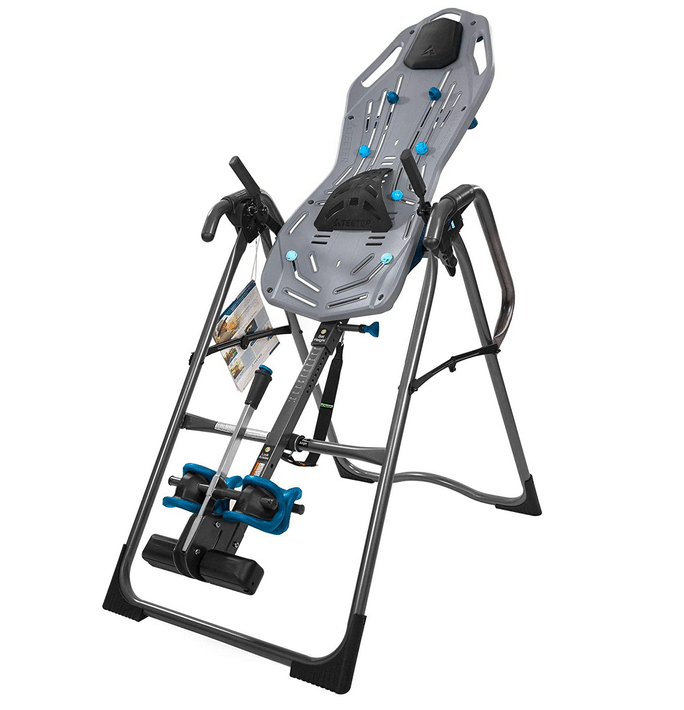
Teeter inversion tables are notable for their unique form factor– instead of a flat backrest with a thick pad over it, they use a curved plastic backrest with openings in it that allow for airflow while reducing weight. This keeps your back cool, but they aren’t quite as soft as other models.
Other than that, Teeter’s big killer app is their acupressure nodes, which can be placed in the openings in the backrest to target specific areas of the back. It’s more work to use, but a Teeter table allows you to target pain points like no other table can which is why we consider them to be the best inversion tables.
Ironman Inversion Tables
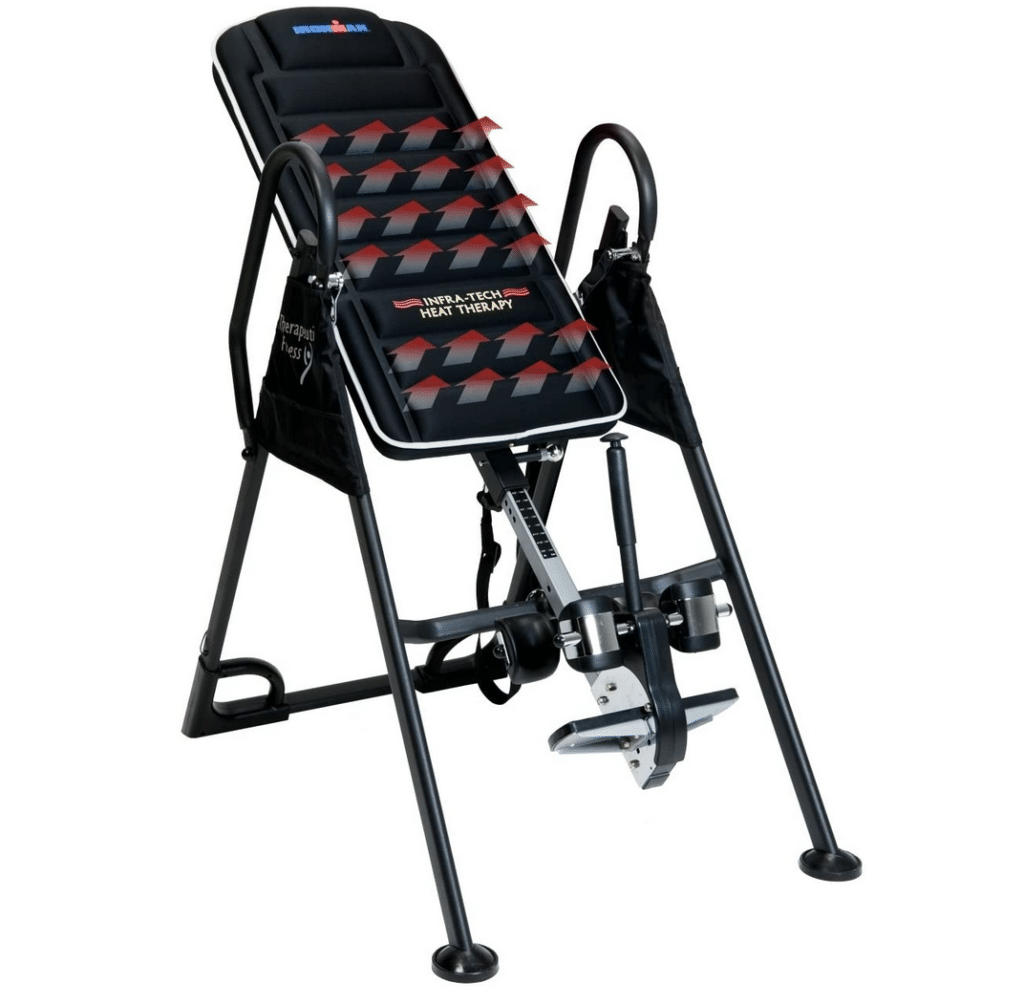
Ironman has been around a long time and is one of the top inversion table brands because it has built a reputation for quality, durability, and ease of use. Most Ironman tables feature a very basic design without a lot of added features other than maybe a lumbar support pad.
However, Ironman’s best inversion table, the Ironman IFT 4000, features a highly innovative infrared therapy feature. This works much like a heating pad, except the infrared light penetrates through the skin before converting to heat inside the muscles, so it does a better job of heating the muscles as opposed to merely heating the skin.
Innova Inversion Tables
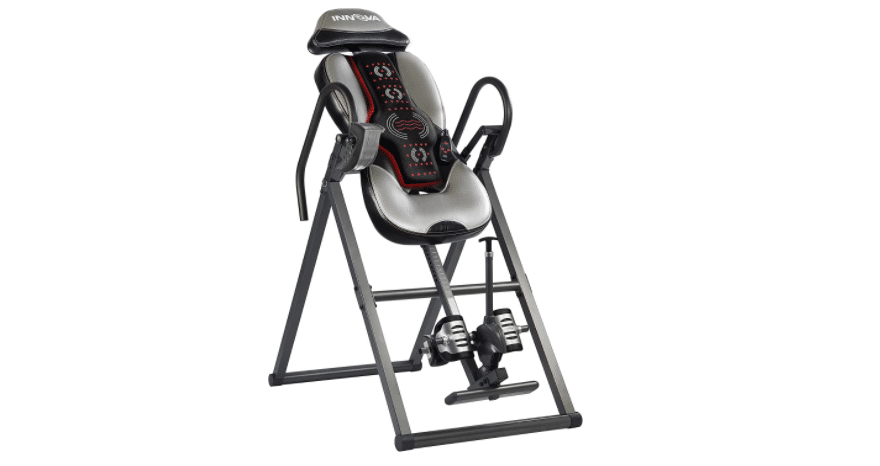
Innova inversion tables combine affordability, comfort, and in some cases advanced heated massage pads. Their best model, the Innova ITM 5900, features a heated massage pad with multiple massage and heat settings that can be set independently.
Exerpeutic Inversion Tables
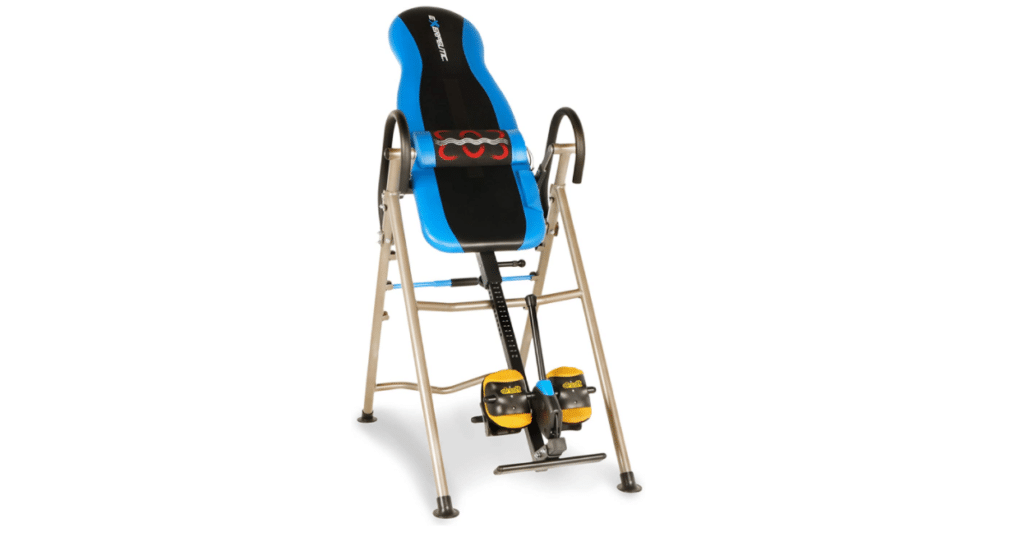
Exerpeutic inversion tables are very similar in design to Innova inversion tables, including the removable heated massage pad. The main addition here is the triple safety ankle locking system.
Health Gear Inversion Tables
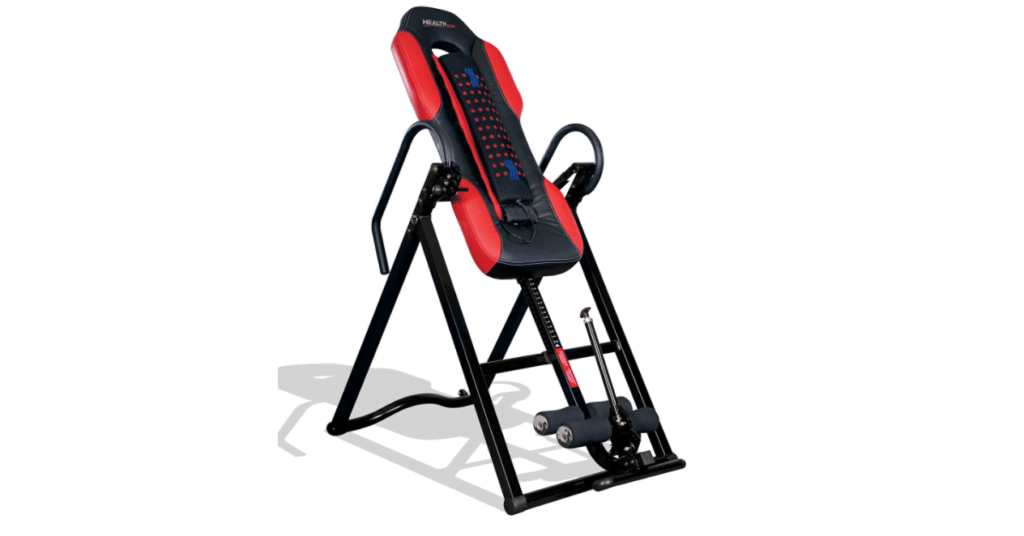
Health Gear inversion tables use the same basic design as most inversion tables, along with advanced massage and heat pad systems. They’re also notable for using memory foam backrests, which provide extra comfort and mold to your back.
Inversion Table FAQs
What Are The Degrees Of Inversion For Inversion Tables?
This tends to be the same across almost all models. Generally, the options are 15, 30, 45, 60, and 85 degrees. However, a few models will offer 75 instead of 85.
Why Are Inversion Tables Not Recommended For Patients With Herniated Discs?
It depends on how bad the injury is and how much weight you’re putting on your back, but overly aggressive inversion may be counterproductive. If a disc is already damaged, full inversion may cause additional trauma. Inversion can be too much of a good thing in some cases.
That said, if you have only a lightly damaged disc and you stick to shallow degrees of inversion, like 15 or 30 degrees, it may still be helpful. Talk to your doctor first, but the mantra here is “less is better.”
Why Do Orthopedic Surgeons And Chiropractors Not Recommend Inversion Tables For Back Pain?
Hard to say. Studies do support inversion therapy for back pain, so your doctor may just not have read the research. But equally, they may have a self-interested motive to focus on medical interventions that they themselves can sell. There’s not really a one size fits all answer here, but many doctors do in fact recommend inversion therapy these days.
Do Inversion Tables Cause Damage To The Door Frames On Which They Are Installed?
All of the inversion tables discussed in this article rest on the floor, and that’s a better approach. Hanging hundreds of pounds of weight from a door frame might very well damage it, not to mention the whole thing could slip off and fall. That said, I have yet to see an inversion table designed to hang from a door frame but will update the answer to this question if I discover one.
How Much Do Inversion Tables Weigh?
Generally, inversion tables weigh around 50-60 pounds. This doesn’t vary much from one table to the next. That said, they come disassembled, and once assembled can be slid along the floor.
Are Inversion Tables Okay To Use When Pregnant?
Inversion tables should be safe for use during the first trimester only. However, it’s best to ask your medical care provider for advice.
Do Inversion Tables Help With Gout?
Probably not. Gout is caused by a buildup of uric acid crystals that pool in the toes. In theory, maybe inversion tables could help move those crystals, but there’s no evidence for that. Ultimately, curing gout requires dietary changes.
Which Inversion Tables Will Medicare Cover?
Medicare will cover inversion tables prescribed by a doctor. That said, insurance billing is really complicated, so some of this comes down to how good a given doctor is at working the insurance coding system.
Are Inversion Tables FSA Eligible?
Yes, as long as your doctor provides a letter explaining that the table is medically necessary.
What Do Doctors Think Of Inversion Tables?
Opinions are mixed, as the research is fairly thin but mostly positive. Many doctors haven’t read the research, and those who have will have different opinions on the good quality vs. low quantity of research. It also depends on what you want an inversion table for – a doctor could rightly like inversion tables for some purposes but not others.
What Type Of Back Problems Are Inversion Tables Good For?
They’re good for treating lower back pain, sciatica, scoliosis, and minor disc injuries. With more serious disc injuries, you have to be careful not to re-aggravate the injury, and even in minor cases, you want to keep the angle of inversion shallow. Inversion tables can’t treat broken backs if that needs to be said.
Do Inversion Tables Make You Taller?
They actually do make you slightly taller, but it doesn’t last. Inversion therapy increases the amount of space between the lumbar vertebrae. In fact, people grow on average a little over half an inch taller just when they sleep at night, so inversion therapy might well increase your height by more than that if you do it long enough.
That said, the height you gain overnight is mostly lost within the first 2-3 hours after waking, and entirely lost by the later afternoon. There’s no reason to think height gained through inversion lasts any longer. So in practice, it shouldn’t be thought of as a way to grow taller.
Studies You Can Read About Inversion Therapy
- Inversion therapy in patients with pure single level lumbar discogenic disease: a pilot randomized trial (Disability and Rehabilitation, 2012)
- A Study of Inversion Traction Therapy: for Lower Back Pain Problems (International Journal Of Engineering Research & Technology, 2019)
- Inversion therapy in patients with pure single level lumbar discogenic disease: a pilot randomized trial (Disability and Rehabilitation, 2012)
- Inversion therapy: a study of physiological effects (The Journal of the Canadian Chiropractic Association, 1985)
- Inversion devices: their role in producing lumbar distraction (Phys Med, 1985)
- Diurnal variation in height and the reliability of height measurements using stretched and unstretched techniques in the evaluation of short-term growth (Annals of Human Biology, 2001)
- Inversion Table Fall Injury, the Phantom Menace: Three Case Reports on Cervical Spinal Cord Injury (Healthcare, 2021)
Looking To Buy The Best Inversion Table? We Recommend Teeter Inversion Tables
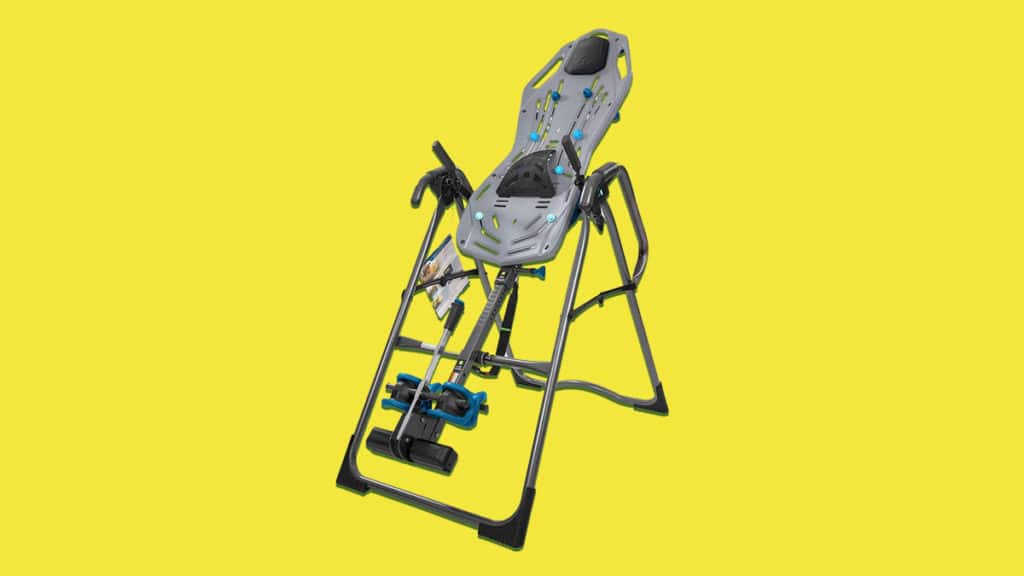
We highly recommend any of the Teeter inversion tables as they are the best inversion tables available today in respect to overall price, targeting specific pain points, and their safety features.
Editor’s note: we are regularly updating this review. If you see any problems, weird interpretations of the data, or just want to say hi, please reach out to hello@the-unwinder.com.
